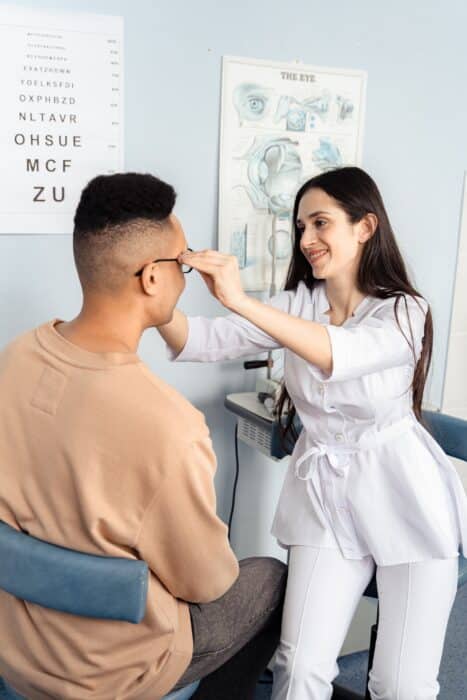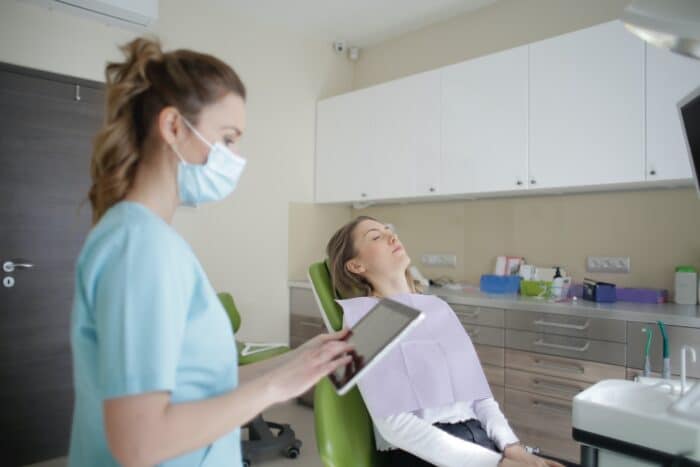Medical assistants are healthcare workers that provide support services to nurses, physicians, and other healthcare professionals. Their duties generally involve clinical and administrative tasks, from assisting physicians with bedside procedures to scheduling appointments.
If you’re here, you might be interested in pursuing a career in this advantageous field. In that case, you should also know that medical assistants can also work in specialized areas, for instance, ophthalmology.
The field of ophthalmology generally focuses on treating eye disorders, sometimes via surgical procedures. Optometry is another eye-related medical field focusing on providing primary eye care.
Medical assistants with ophthalmologists tend to work in ophthalmology or optometry clinics, helping patients with eye care.
If you are interested in becoming an ophthalmologist medical assistant, read on to find out everything you will need to know about who they are, what they do, certified medical assistant salary, and more.
Also see: Is Medical Assistant a Good Career?
Who Are Ophthalmic Medical Assistants?
An ophthalmic medical assistant is a healthcare worker that provides support services to ophthalmologists and optometrists.
Their duties involve both administrative and clinical tasks, ranging from scheduling appointments, verifying glass prescriptions, and checking any issues with patients’ visions.
Ophthalmic medical assistants usually have varied work settings, including working in hospitals or private eye clinics.
Read more: What is a Medical Assistant?
What Does an Ophthalmic Medical Assistant Do?
As mentioned earlier, all medical assistants generally perform both clinical and administrative duties. The same goes for ophthalmic medical assistants.
Let us take a look at these duties in detail-
Administrative Duties
- Scheduling appointments–
Medical assistants are required to handle bookings, rescheduling, and cancellations of appointments. They need to also remind the patients of upcoming meetings. - Answering phone calls–
Medical assistants are considered the face of the clinic or office since they are usually the first point of contact for patients. They can answer calls, solve patients’ queries, and more over the phone. - Managing paperwork–
Ophthalmic medical assistants are required to fill out the required paperwork, which may include DMV forms, that help a patient get the care they need. They are also required to help the patients fill out any forms or paperwork, such as questionnaires. - Maintenance–
There is a variety of different essential tools that are used in an ophthalmologist’s office, such as autorefractors and phoropters, among others. Medical assistants are required to maintain the cleanliness and smooth functioning of such expensive and valuable tools, in addition to maintaining cleanliness around the whole office. - Restocking supplies–
Any clinic or office needs appropriate and timely restocking of its supplies to run smoothly. Medical assistants have to regularly check the inventory and ensure all the essentials are restocked on time.
Read more on Medical Administrative Assistant
Clinical Duties
- Using lensometers–
Lensometers are instruments used in ophthalmologists’ offices to check the prescription of glasses. Medical assistants may be required to use them and thus need to know the basics of using this machine, which comes both in automatic and manual forms. - Checking patient’s visions–
Eye examinations are usually conducted by ophthalmologists, however, medical assistants can perform this test under supervision or assist the physician as and when required. These tests are conducted to test how well a patient’s vision is, both with and without glasses. - Performing pre-tests–
Medical assistants can be asked to perform pre-testing before an eye examination, which usually involves checking the eye pressure of the patient using an autorefractor. - Recording patient care history–
Before each patient visits, it is important to note the case history. Medical assistants are required to ask questions such as when the last eye exam was taken, their medical histories, and if they are taking any prescribed medications.
Read more on Certified Clinical Medical Assistant
Where Do Ophthalmic Medical Assistants Work?
As mentioned earlier, ophthalmic medical assistants tend to work in healthcare settings that provide eye care, which can include private clinics or hospitals.
Since they work in close proximity to ophthalmologists or optometrists, they can be found wherever these healthcare professionals work.
Read: 12 Reasons to Become a Medical Assistant
There are differences in working hours and environment between the type of work settings ophthalmic medical assistants choose. For instance, if you choose to work in a private clinic, you can expect fewer employees as compared to a hospital.
Due to this, their duties may vary and include additional responsibilities, and their work timings are usually flexible.
In contrast, if you choose to work in a hospital setting, you will be required to work in a more fast-paced and dynamic environment. Hospitals also tend to see more patients on a typical day than any private clinic.
Hence, medical assistants working in such settings may be required to work longer hours or multitask efficiently.
Also read: Where Can Medical Assistants Work?
What Are The Skills Required To Become An Ophthalmic Medical Assistant?
A successful ophthalmic medical assistant needs to have a specific skill set that sets them apart. Employers highly prefer medical assistants that have the following skills-
- Communication-
Since medical assistants are usually required to interact with patients regularly, they need to be able to address their concerns respectfully. This requires good communication skills since they also have to give instructions to patients before or after a procedure. - Dexterity-
Ophthalmic medical assistants usually have to work with many specialized instruments and tools, such as autorefractors. They need to have good hand-eye coordination and dexterity to be able to handle such equipment with ease. - Basic computer skills-
Just like in all other healthcare settings, ophthalmologic and optometric offices also uses electronic health records. Medical assistants need to be able to navigate through these digital platforms and also know how to handle basic Microsoft Office applications. - Organization-
Ophthalmic medical assistants, like all other medical assistants, need to multitask during a typical workday. They need to have good organizational and time management skills to be able to handle several tasks efficiently.
These are the general skills that are required by ophthalmic medical assistants, in addition to basic medical assistant skills.
What Is the Salary And Job Outlook for Ophthalmic Medical Assistants?
According to the U.S. Bureau of Labor Statistics (BLS), medical assistants, in general, have a national average salary of $37,190 per year. These figures are highly dependent on factors such as job location, experience, specializations, etc.
Even though there is no government data available for ophthalmic medical assistants and how much they earn, job board sites such as glassdoor.com report that they make much more than medical assistants who do not work under specialized physicians.
The average salary for ophthalmic medical assistants was reported to be $45,673.
The BLS also reported that the job outlook for medical assistants looks fairly positive for the next few years (See: Medical Assistant Job Outlook),
with the reported job growth expected to increase by 16% by the year 2031, which is far more than any other profession.
Read more on Certified Medical Assistant Salary

Do You Want To Become a Medical Assistant? Check Out Free Medical Assistant Masterclass!
In our masterclass you learn:
- How to be a medical assistant faster…in just 4 months!
- Avoid student debt & driving to classes
- #1 thing employers want from Medical Assistants
- How to stand-apart & get a university certificate for a strong resume
How To Become an Ophthalmic Medical Assistant?
If you wish to become an ophthalmic medical assistant, you might be wondering what the process entails. Becoming an ophthalmic medical assistant is similar to becoming a regular medical assistant.
Here is how you can become one-
1. Complete your high school diploma or a GED
The minimum requirement for becoming an ophthalmic medical assistant is to complete your high school diploma or a GED.
2. Get medical assistant training
Even though not necessary, most employers prefer candidates who undertake medical assistance training, as this helps you gain the necessary skills required to perform the day-to-day tasks.
There are three main methods of getting your medical assistant training, getting an associate’s degree from a technical university, getting a diploma from a community college, or completing an online training program.
See more on: Medical Assistant Degree vs Certificate
Completing your training through online training programs is the most recommended, as it offers several advantages over other methods.
Read also: Medical Assistant Programs Cost
It allows you to complete your training much faster, in as little as 6 months, allows you to learn at your own pace and schedule and from the comfort of your own home, and costs much lesser than its alternatives.
Also read: Is Medical Assistant Degree Required?
3. Apply for externships
If you opt for online training programs, they usually offer externship opportunities after you finish your course. However, you can also choose to apply for externships at companies you have shortlisted on your own.
An externship will provide you with the essential hands-on job training that will help you step foot into the workforce smoothly.
See more on: Medical Assistant Externship
Medical Assistant On-the-Job Training
4. Get Certified-
Although not necessary, employers highly prefer candidates who obtain their certifications, which implies that they have the necessary skills and educational competence to handle the responsibilities of a medical assistant.
There are many types of certifications available for medical assistants, however, the most prominent and well-accepted ones are the CCMA, RMA, and CMA certifications.
Also read: Medical Assistant Certificate Requirements
5. Apply for Jobs-
Now that you’re a certified medical assistant specializing in ophthalmology, you can start applying for jobs in the type of work setting that is best suited for you.
Also see: How to get Medical Assistant jobs with no experience
Conclusion
The role of an ophthalmic medical assistant shines brightly in the world of eye care. Their multifaceted responsibilities, spanning from administrative duties to aiding in eye examinations and procedures, are fundamental to the efficiency of ophthalmology practices.
These dedicated professionals assist ophthalmologists, conduct vision tests, manage patient records, and offer vital support to both eye care providers and patients. Their expertise plays a vital role in maintaining eye health and ensuring a positive experience for individuals seeking vision care, making them indispensable in the realm of ophthalmology.
See Other Types of Medical Assistants:
- Cardiology Medical Assistant
- Podiatric Medical Assistant
- Dermatology Medical Assistant
- Pediatric Medical Assistant
Related Resources:
Related Articles
-
How to Be Successful in College in 2022 – 7 Simple Tips to Succeed
-
How Do Scholarships Work? Read This First…Truth is Shocking
-
7 Best College Majors 2024: What Should I Major In?
-
How to Choose a College – 10 Things You Must Consider in 2024
-
Why Go to College? Top 13 Benefits for Adult Students in 2022
-
Top 5 Best Alternatives to Community College for 2024








